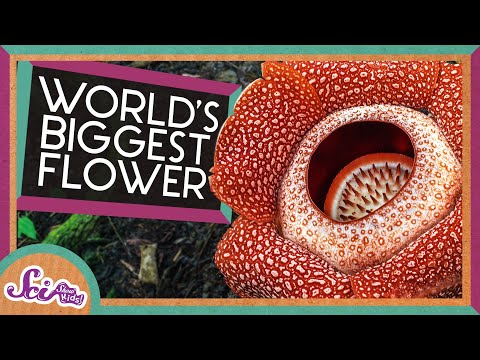You're right... Oh! Hi there! Squeaks and I are deciding what flowers to plant in our garden next.
没错……哦!嗨,大家好!我和吱吱正在讨论接下来在花园里种什么花儿。
We're thinking of planting some daisies, maybe some sunflowers — lots of big, beautiful blooms.
我们打算种些雏菊,或许再种些向日葵——会开很多又大又漂亮的花。
Squeaks wants really big flowers, the biggest in the whole world!
吱吱想种那种很大很大的花儿,种世界上最大的花儿!
But… I'm afraid the biggest flower in the world would be really unusual to have in our garden, Squeaks — because unlike other flowering plants, it lives inside another plant!
但是……我担心如果我们的花园里有世界上最大的花,那就太不寻常了,因为它和其它的花儿不一样,它生活在另一种植物里面。
This is the biggest flower in the world: Rafflesia arnoldii.
这就是世界上最大的花:大王花。
It lives in Indonesia, and its flowers are almost a meter across.
它生活在印度尼西亚,它的花有将近一米宽。
That means you'd struggle to fit one through your front door!
这就意味着你很难把一朵大王花弄进你家的前门!
They're also very heavy for flowers.
此外,作为一种花,它还很重。
They can weigh up to about seven kilograms — roughly the weight of a bowling ball! That's a big flower.
它的重量可以达到7公斤——大概有一个保龄球那么重了!真的是很大的花儿了。
Well hold on, Squeaks.
淡定,吱吱。
Before you make any decisions, you should know they're also very smelly.
在你做决定之前,你要知道,这种花很臭。
Some people even call them "corpse flowers"... because they smell like rotting meat.
有人甚至称它们为“尸花”……因为它们闻起来就像腐肉。
That's a great question, Squeaks! Why does this flower stink so much, when most flowers smell nice?
问得好,吱吱!为什么别的花都是香的,而它却这么臭?
Well let's think about it for a moment. How might smelling good help the flower?
咱们先思考一个问题:气味对花有什么帮助呢?
Right! Smelling good attracts pollinators!
没错!好闻的气味会吸引授粉者!
Pollinators are animals like bees that help flowering plants make seeds by moving their pollen from one flower to another.
像蜜蜂这样的授粉者会将花粉从一朵花转移到另一朵花上来帮助开花植物产生种子。
Many pollinators are attracted to sweet smells because they eat sweet things, like the nectar flowers make.
许多授粉昆虫会被甜甜的气味吸引,因为它们就爱吃甜的,比如花的花蜜。
Well, this flower is also trying to draw in pollinators — but it's not after bees.
嗯,大王花也会吸引授粉者——但它吸引的并不是蜜蜂。
Its powerful, stinky smell attracts flies.
它用它强烈的臭味吸引的是苍蝇。
These flies like to eat dead animals, so they go into the flower thinking that stinky smell is some yummy, old meat.
苍蝇喜欢吃动物的尸体,所以它们会进入臭臭的大王花里,它们以为里面是美味的腐肉。
And while they're inside investigating the stench, they get the flower's pollen on them!
而当它们在里面寻找臭味的时候,它们的身上就会蹭上花粉!
They carry this pollen with them when they leave.
走的时候就会带上这些花粉出去。
And that means, when they check out another flower, they leave some of it behind.
当它们再进去另一朵花时,它们就会把花粉留在那里。
So the smell is the plant's way of getting the flies to move their pollen around!
所以臭味是大王花让苍蝇帮忙传播花粉的方式。
Oh, what do the leaves look like?
哦,它的叶子看上去像什么?
Well, that's the weird thing.
嗯,这就是它奇怪的地方。
This flower actually doesn't have any leaves, or roots, or even a stem that we can see.
大王花其实没有叶子,也没有根,甚至连茎都没有。
That's a really good question!
这是一个非常好的问题!
All plants need water and light to grow.
所有的植物都需要水和光来生长。
Most flowers use their roots to suck up water from the soil, and their leaves to collect light from the sun, so they can make food for themselves.
大多数的花都会用根从土壤里吸收水分,用叶子收集太阳光,这样它们就可以为自己制造食物。
But this flower doesn't have those parts. So how does it live and eat?
但大王花没有那些身体部位,那它吃什么呢?怎么生存呢?

Well… it's what scientists call a parasite — a living thing that steals from other living things to survive!
嗯,这就是科学家所说的寄生虫——一种靠从其他生物那里偷东西来生存的生物!
Like, you might be familiar with fleas.
比如,你可能对跳蚤很熟悉。
They're parasites that feed on the blood of animals, including people.
它们是寄生虫,以动物的血液、包括人的血液为食。
Their bites often leave itchy, red bumps on your skin which are really annoying.
它们的叮咬往往会在你的皮肤上留下发痒的红色肿块,这真的很烦人。
In the case of Rafflesia, it steals the water and food it needs from another plant.
而大王花也是从另一种植物那里偷取它所需要的水和食物。
And it does this by growing inside it!
它会寄生在别的植物里!
Rafflesia seeds are really tiny, so they can get into small scratches on the roots or stem of the vines they live inside.
大王花的种子非常小,所以它们可以进入自己所生活的藤蔓的根部或茎部的小划痕中。
And once in there, it steals what it needs to grow.
种子一旦进去,它就会偷走自己生长所需的东西。
It takes food the vine made from sunlight using its leaves and water the vine sucked up from the soil using its roots.
偷走藤蔓用自己的叶子从阳光中获取的食物,用根从土壤中吸收的水分。
So the Rafflesia doesn't need leaves or roots of its own.
所以大王花不需要叶子和根部。
And that means it can put all of its efforts into making massive flowers!
这样它就可以把所有的劲儿都使在花朵上!
When the flower buds are ready, they burst out of the vine to bloom.
当花蕾成熟时,它们就会从藤蔓里绽开。
The flowers do hurt the vine — kind of like how flea bites don't feel awesome.
大王花确实对藤蔓有伤害——就和被跳蚤咬了的感觉是一样的。
But they don't kill it.
但它不会杀死藤蔓。
Parasites need the living things they steal from, so they usually don't kill them.
寄生的生物需要利用宿主,所以它们通常不会杀死宿主。
So what do you think, Squeaks?
所以吱吱,你现在怎么想?
Do you still want to grow the biggest flowers in the world here?
你还想在这里种世界上最大的花吗?
Oh, that's true.
哦,是的。
The vine and Rafflesia arnoldii both grow really far away, in a very different habitat, than what we have here at the Fort.
藤蔓和大王花都生长在非常遥远的地方,它们的栖息地和城堡这里非常地不同。
Maybe we can grow something else that would remind us of this awesome and smelly plant.
或许我们可以种一些别的植物,和可怕又难闻的大王花有什么关系的植物。
That's a great idea.
好主意。
We can research and find out if there are any plants that are parasites living near the Fort, and maybe try growing some of those.
我们可以看一下城堡附近有没有寄生植物,或许可以试着种一些。
Plants have so many amazing ways to get what they need.
植物有很多奇妙的方法来获得它们需要的东西。
Some grow in the ground, while some grow out of other plants.
有的长在地里,有的长在其它的植物上。
And some smell sweet, while others put up a big stink.
有些闻起来很香,有些则臭气熏天。
I wonder what you could learn about the plants in your area by looking closer!
我在想,如果大家仔细观察,或许也能对附近的植物有所了解。
Maybe you could start a journal to record all the different flowers you see, and write down what they smell like.
你可以写日记,记录自己看到的所有不同的花,并写下它们的气味。
And as always, if you want to keep exploring with me, Squeaks, Jessi, and all the rest of our friends, make sure to click the subscribe button.
还是那句话,如果你想和我、吱吱、杰西以及我们所有的朋友一起探索,一定要点击订阅按钮。
We'll see you next time here at the Fort.
我们下期城堡见。












